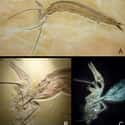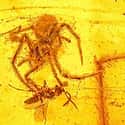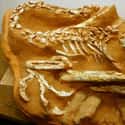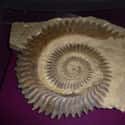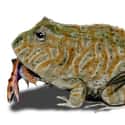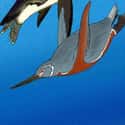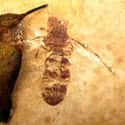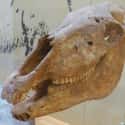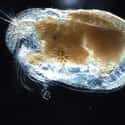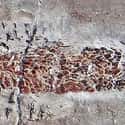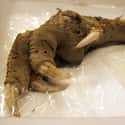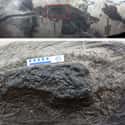-
(#1) A Velociraptor And Its Prey Were Fossilized Mid-Combat
Velociraptors are poorly understood outside of the paleontological community, mostly due to inaccuracies in the Jurassic Park franchise. No, velociraptors were not six-foot-tall, hyper-intelligent carnage machines. The velociraptor was actually about the size of a turkey and more of a scavenger than a predator. Still, that doesn't mean that some raptors weren't predatory in nature.
One fossil actually captures a raptor preying on a Protoceratops, but the fight was much closer than you'd imagine. The raptor had pierced the Protoceratops with its massive toe claw, but the Protoceratops managed to bite and break the raptor's arm using its powerful beak. The two passed together, probably due to the unexpected collapse of a sand dune.
-

(#2) A Dinosaur Tail Covered In Feathers Was Found Trapped In Amber
Scientists were thrilled at the announcement of a 99 million-year-old dinosaur tail found encased in amber - one of the rarest and most unique discoveries in all of paleontology. The tail, which was completely covered in feathers, is further evidence in the debate that many dinosaur species were actually covered in downy feathers.
The tail is one of the most perfectly preserved dinosaur appendages ever discovered. Evidence suggests the tail belongs to a Sotr, a bipedal theropod.
-
(#3) A Pterodactyl-Eating Fish Met Its End In The Middle Of A Meal
If you can believe it, there was a time when giant fish were literally plucking winged reptiles from the sky. That's exactly what happened with this fossil, which depicts an Aspidorhynchus munching on a small pterosaur known as Rhamphorhynchus. Unfortunately for both predator and prey, neither one would escape this encounter alive.
The pterosaur proved too large for the Aspidorhynchus, which may have gotten its teeth stuck in the flying reptile's leather wing. The pterosaur likely ran out of oxygen, and the monster fish probably starved soon after.
-
(#4) Researchers Found A 100 Million-Year-Old Spider And Its Meal Encased In Amber
Roughly 100 million years ago, spiders were just as terrifying as they are now. Need proof? How about this piece of amber that was discovered with a perfectly preserved spider inside. The spider was in the middle of consuming a juvenile wasp when both predator and prey were engulfed in tree sap. This particular species of wasp preys on spider eggs, so the wasp might have had it coming in this situation.
The fossilized amber was found in Myanmar. It's the only example of a spider fossilized during a hunt.
-
(#5) One Dinosaur Was Preserved While Incubating Her Nest
One fossil of a dedicated mother incubating her eggs made waves when it was discovered in the Gobi Desert. The 80 million-year-old Oviraptor helped prove that some dinosaurs had strong parental instincts at a time when there was little evidence to support the idea. It also strengthened the idea that dinosaurs and birds were remarkably similar.
The poor mother was likely covered in sand while defending her nest from the elements, immortalizing her as one of the best mothers of prehistory.
-
(#6) 2 Mammoths Accidentally Locked Tusks While Fighting And Likely Starved
Mammoths were massive animals, so it's not surprising that a fight between two of these behemoths could turn deadly. A 20-year-old paleontologist made a once-in-a-lifetime discovery in 1962 when he was excavating a mammoth skeleton only to find another mammoth tangled up in its tusks. The two had locked tusks while sparring, the last mistake they would ever make.
Researchers believe the two mammoths were likely fighting over mating rights with a female before the fight turned ugly. One mammoth's tusk was found embedded in the other's eye socket, but neither could gain enough of an edge on their opponent for there to be a true winner.
-
(#7) The Helicoprion Was A Shark With A Buzzsaw In Its Mouth
Perhaps one of the most bizarre and horrible creatures to ever terrorize the sea, Helicoprion was a shark species known only by fossils of its frightening teeth. Sharks are cartilaginous - meaning they don't have bones capable of being fossilized - so most extinct sharks are known only by what was in their mouths. Scientists struggled for years to explain the unique spiral shape of Helicoprion's teeth.
At first, it was believed that the extinct shark had a buzzsaw-shaped mouth, but further research suggests that the teeth were actually situated inside Helicoprion's lower jaw.
“Continual growth of the whorl pushes the tooth–root complex in a curved direction towards the front of the jaw, where it eventually spirals to form the base of the newest root material, and this process continues to form successive revolutions,” researchers wrote in 2013. “At some time, prior to a complete 360 degree evolution of spiral growth, tooth crowns are concealed within tessellated cartilage on the upper jaw.”
-
(#8) Beelzebufo Was A Frog That Ate Dinosaurs
Modern Madagascar is filled with some of the most unique wildlife on the planet, but go back 68 million years and you'll find a creature much more terrifying than anything alive today. Beelzebufo ampinga was a species of ancient frog that had a bite strong enough to prey on and eat small dinosaurs. They had massive, gaping jaws that were much more powerful than those of modern amphibians.
The bite force of these terrifying frogs was equivalent to modern day wolves and tigers, making it one of the most ferocious amphibians of all time.
-
(#9) Peru Was Once Home To Giant Penguins
Penguins are adorable, but scale them up to human height and they become a bit less cuddly. These massive penguins, known as Inkayacu paracasensis, were about five feet tall and one of the largest species of penguin ever discovered.
The 36 million-year-old find was incredible, and not just because of the size - along with the bones, scientists found preserved evidence of both scales and reddish-brown stomach feathers.
-
(#10) Scientists Found A Mosquito Trapped In Amber, Just Like In 'Jurassic Park'
For many fossil enthusiasts, the movie Jurassic Park was their first introduction to the prehistoric world. In the movie, dinosaurs are brought back to life using DNA found in ancient mosquitoes trapped in fossilized amber. In October 2013, a real-life blood-filled mosquito was rediscovered after being forgotten in a basement for over 30 years. The fossil was originally found in Montana, but the immensity of the discovery was not realized for decades.
Unfortunately, it's impossible to tell what animal the 46 million-year-old mosquito had feasted on when it became encased in amber. DNA simply can't survive for such a long period of time, no matter how well it is preserved. The dream of a real-life Jurassic Park is sadly an impossibility that is more science fiction than fact.
-
(#11) Giant Ants The Size Of Hummingbirds Once Terrorized Wyoming
Sometimes extinction is a good thing. The modern residents of Wyoming can sleep easier knowing that this terrifyingly large ant species, Titanomyrma lubei, has been extinct for at least 50 million years. The ants were about two inches long, more than big enough to pack a serious bite.
These animals required warm temperatures to survive, which could give us a glimpse into why these gigantic insects eventually perished.
-
(#12) A Paleontologist Discovered That Rhinos And Other Exotic Animals Once Lived In England
While modern England is not exactly known for its exotic wildlife, the discovery of Kirkdale Cave changed the perception of prehistoric England forever. Initially discovered in 1821, the cave was thought to be little more than the resting place of a herd of unlucky cattle.
Further analysis showed that the bones found in the cave were not from cattle, but from a whole host of animals no longer found in England, including rhinos, hippos, mammoths, and hyenas. The small cave was too narrow to fit most of these species, so it is believed that the cavern was actually a den that hyenas used to haul their meals into for safe dining.
-
(#13) Two Turtles Were Fossilized While Mating
Getting caught in the act is an embarrassing experience for any couple, but nothing compares to these two turtles who were discovered after being fossilized mid-copulation. The 47 million-year-old couple was unearthed by German scientists excavating at the Messel Pit, a famous dig site.
The specimens are the first ever vertebrate fossils to be discovered while engaging in intercourse at the moment of their demises. Researchers theorized that the turtles experienced carbon dioxide poisoning after sinking deeper into the lake and entering a deposit of deadly gas.
-
(#14) Trilobites Had Gigantic Orgies, And Some Have Been Preserved Forever
The animal kingdom can be pretty kinky sometimes and even some of the oldest species on Earth were more liberated than modern humans. Take trilobites, one of the more recognizable fossils in the world: These tiny arthropods commonly engaged in massive orgies, sometimes with as many as a billion sexual partners all scurrying across each other. So many of these orgies have been observed that scientists believe this was a pretty normal occurrence for these frisky creatures. They even got naked to perform the deeds, shedding their tough exoskeletons to expose the soft flesh underneath.
On occasion, these event would end in disaster as the mass of aroused trilobites would be smothered by sediment. Luckily for us, one species's sexual tragedy is another's scientific discovery.
-

(#15) Scientists Discovered 50 Million-Year-Old Sperm In Antarctica
A group of fossilized sperm cells rocked the paleontological community and made history as the oldest sperm ever found. The 50 million-year-old sperm came from a species of annelid Antarctic worm, one that is related to modern earthworms and leeches but is now long extinct.
The sperm was preserved in a cocoon, one that scientists believe the worms created for the sole purpose of getting down and dirty. This discovery is so remarkable because fossilized sperm is an incredible rarity, regardless of the age.
-
(#16) Someone Found A Fossilized Penis And It's The Oldest One In History
There are just so many interesting things about the genitalia of this ancient crustacean. The animal, known as an ostracod, was the proud owner of the oldest intact penis ever discovered by science. These creatures had huge sperm in proportion to their body size - the largest of any known species - but that's not even the most amazing part of the story: "It doesn't have one penis, it has two," said Professor David Siveter, a researcher with the University of Leicester.
This 100 million-year-old fossil is definitely one of the weirdest discoveries in modern scientific history.
-
(#17) A 200 Million-Year-Old Undersea Attack Was Frozen In Stone
Paleontologists at the University of Plymouth discussed their analysis of a 23-inch stone fossil of an ancient squid called Clarkeiteuthis montefiorei with its tentacles wrapped around its prey. The 200 million-year-old fossil, found on the Jurassic coast of southern England in the 19th century, is the oldest known record of such a palaeobiological event. The analysis was accepted for publication in the Proceedings of the Geologists' Association journal, where researchers will detail their theories about how the incident was preserved, and how the squid crushed its prey.
The paleontologists suggest the fish that the squid attacked was too large and became stuck in its jaws, settling on the ocean floor where both animals remained, deceased. Alternatively, the squid may have suffocated when it sank to the sea floor with its prey to avoid being attacked by another predator.
-
(#18) The Smallest Known Dinosaur From The Mesozoic Era Was Preserved In Amber
Scientists discovered a dinosaur approximately the size of a bee-hummingbird preserved in amber. According to a Nature article, the new species named Oculudentavis khaungraae was recovered from 99-million-year-old amber from northern Myanmar. Due to its minature size, the creature has a "unique pattern of cranial fusion and an autapomorphic ocular morphology." In other words, it has lizard-like eyes defined by a small pupil.
The O. khaungraae is the smallest known dinosaur from the Mesozoic Era to date. Its skull is birdlike and about 7 millimeters long. Jingmai O’Connor, the lead author of the study and a paleontologist from the Institute of Vertebrate Paleontology and Paleoanthropology in Beijing, China, said it's "the weirdest fossil [he's] ever been lucky enough to study."
Roger Benson, a paleobiologist from the University of Oxford, explained the "miniature body sizes in birds evolved earlier than previously recognized, and might provide insights into the evolutionary process of miniaturization."
-
(#19) The Claw Of A Moa, A New Zealand Bird That Went Extinct 600 Years Ago, Has Been Preserved
Although some people have claimed this preserved claw is from a dinosaur, that is not true. It's actually the preserved foot of a moa, a giant flightless bird from New Zealand that went extinct more than 600 years ago when people arrived in the area.
Archaeologists discovered the fossil, flesh and skin still intact, in a cave. Analysis revealed that the 3,300-year-old mummified claw belonged to an upland moa (Megalapteryx didinus), one of the smallest moa species, reaching 4.2 feet tall at most.
The claw was likely preserved because the upland moa perished in a cool, dry cave that provided natural conditions for preservation.
-
(#20) Siberian Scientists Found Nearly An An Entire Woolly Mammoth Skeleton Along With Its Skin, Wool, And Dung
In July 2020, a reindeer herder noticed the skull of a woolly mammoth sticking out of a lake in northeastern Siberia. Scientists who subsequently excavated the site discovered about 90% of the male mammoth's entire skeleton, along with some of its skin, wool, and other soft tissues (such as ligaments), and even its fossilized poop (called a coprolite).
Pavel Kosintsev, a senior researcher from the Institute of Plant and Animal Ecology in Russia at the Urals Branch of the Russian Academy of Sciences, told Live Science that finding any kind of fossilized soft tissue is rare, and "coprolites are even rarer. Scientists know no more than 10 [mammoth] coprolites."
The mammoth likely perished at least 10,000 years ago, and was well-preserved due to Siberia's cold temperatures. The skull became visible when the lake's water levels went down due to rising temperatures.
-
(#21) A 15-Foot Ichthyosaur Was Found With The Torso Of A 13-Foot Reptile In Its Stomach
About 240 million years ago, an ancient reptile got a mouthful, and then some. Paleobiologists studying the remains of a 15-foot-long marine reptile called an ichthyosaur discovered the remains of another swimming reptile fossilized in its stomach. The reptile in the tummy, a thalattosaur, at 13 feet long was nearly as long as its predator (although the smaller animal's remains did not include the head and tail).
According to researchers who reported their results in August 2020 in iScience, the fossil "likely represents the oldest evidence for predation on megafauna; i.e., animals equal to or larger than humans, by marine tetrapods." The thalattosaur might have been so large that the ichyosaur perished while attempting to eat/digest it.
New Random Displays Display All By Ranking
About This Tool
Fossils are formed under tremendous pressure for millions of years. They tell us the stories of ancient ancestors and ancient history, as well as the strange creatures of their time. With the development of archeology techniques, the discovery of strange fossils has become more and more common around the world. These fossils have also changed humans' perception of the world forever.
Some of the most bizarre fossils may look like alien creatures, and you must see them with your own eyes to believe their existence. The random tool shows 21 remnants of the oldest life forms on earth that preserved in the rocks.
Our data comes from Ranker, If you want to participate in the ranking of items displayed on this page, please click here.












